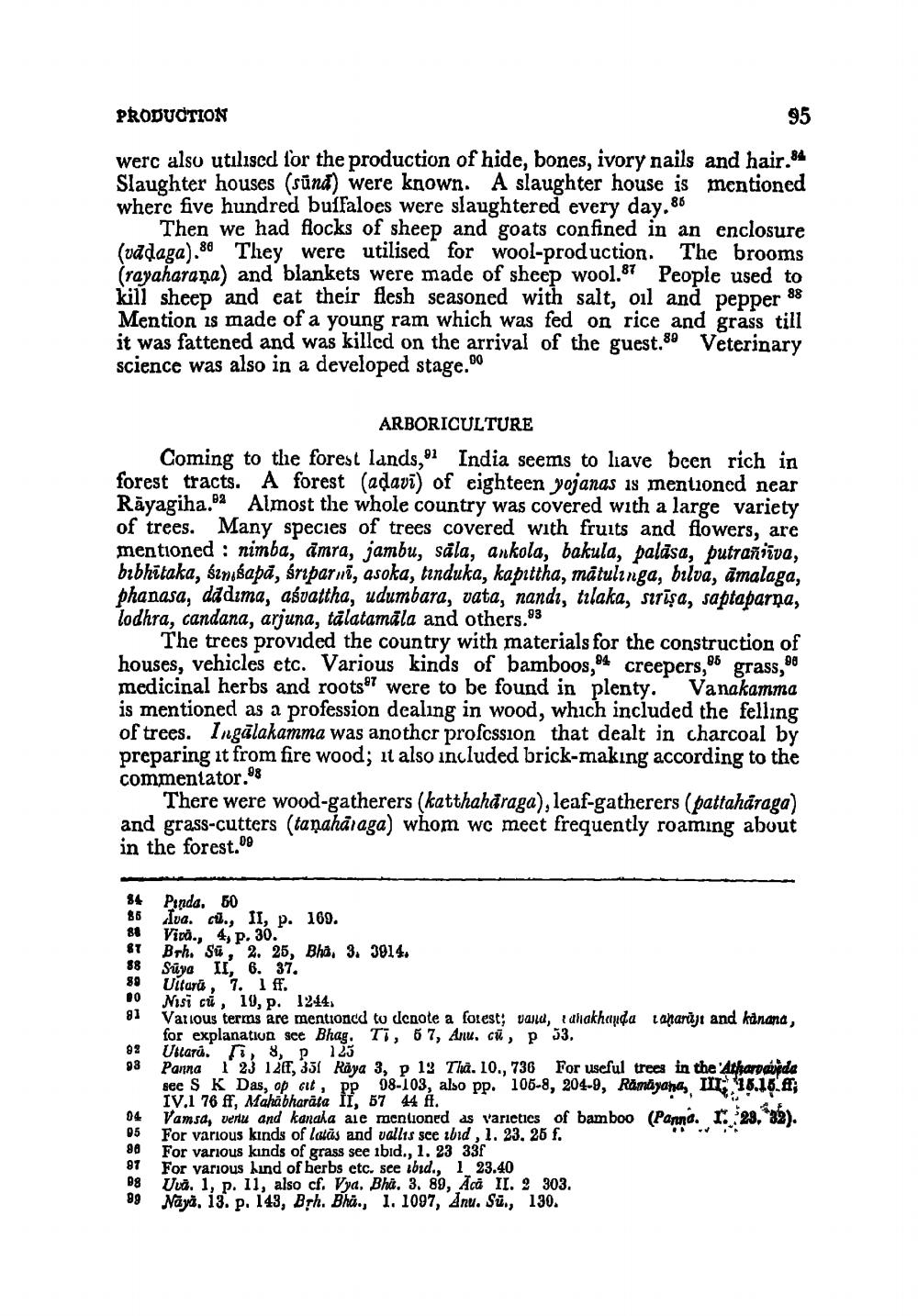________________
PRODUCTION
95
werc also utilised for the production of hide, bones, ivory nails and hair.84 Slaughter houses (sünd) were known. A slaughter house is mentioned where five hundred buffaloes were slaughtered every day. 86
Then we had flocks of sheep and goats confined in an enclosure (vadaga).80 They were utilised for wool-production. The brooms (rayaharana) and blankets were made of sheep wool.87 People used to kill sheep and eat their flesh seasoned with salt, oil and pepper 88 Mention is made of a young ram which was fed on rice and grass till it was fattened and was killed on the arrival of the guest.89 Veterinary science was also in a developed stage.
ARBORICULTURE Coming to the forest lands,91 India seems to liave been rich in forest tracts. A forest (adavī) of eighteen yojanas 18 mentioned near Rāyagiha. Almost the whole country was covered with a large variety of trees. Many species of trees covered with fruits and flowers, are mentioned : nimba, amra, jambu, sala, ankola, bakula, palāsa, putrañiiva, bibhitaka, sinasapă, sriparnī, asoka, tinduka, kapittha, matulinga, bilva, āmalaga, phanasa, dadıma, aśvattha, udumbara, vata, nandı, tılaka, sirīşa, saptaparna, lodhra, candana, arjuna, talatamala and others.93
The trees provided the country with materials for the construction of houses, vehicles etc. Various kinds of bamboos, 84 creepers, grass, 90 medicinal herbs and rootse were to be found in plenty. Vanakamma is mentioned as a profession dealing in wood, which included the felling of trees. Ingalakamma was another profcssion that dealt in charcoal by preparing it from fire wood; it also included brick-making according to the commentator.88
There were wood-gatherers (katthaharaga), leaf-gatherers (pattahäraga) and grass-cutters (tanaharaga) whom we meet frequently roaming about in the forest.09
84 86
Pinda. 50 Iva. c., II, p. 169. Vira., 4, p. 30. Brh. Su,2. 25, Bha, 3. 3914. Suya II, 6. 37. Uitara, 7. I ff. Nisi cú , 19, p. 1244. Various terms are mentioned to dcnote a forest; and, ialakhanda tanarījt and kanana, for explanation see Bhag. Ti, 67, Anu, cū, P 33. Uttard. 8, P 125 Panna 123 12f, 331 Raya 3, p 13 Tha. 10., 736 For useful trees in the Atharpada see S K Das, op cit, pp 98-103, also pp. 105-8, 204-9, Ramayana, III.18.16.ff; IV.1 76 ff, Mahabharata II, 57 44 A. Vamsa, verlu and kanala ale mentioned as varieties of bamboo (Panna. 1.. 28. *32). For various kinds of latās and vallis sce ibid , 1. 23. 26 f. For various kinds of grass see ibid., 1. 23 33f For various kind of herbs etc. see ibid., 1 23.40 Ur. 1, p. 11, also cf. Vya, Bha. 3. 89, Aca II. ? 303. Naya, 13. p. 143, Brh. Bha., l. 1097, Anu. Sü, 130.
88 99




